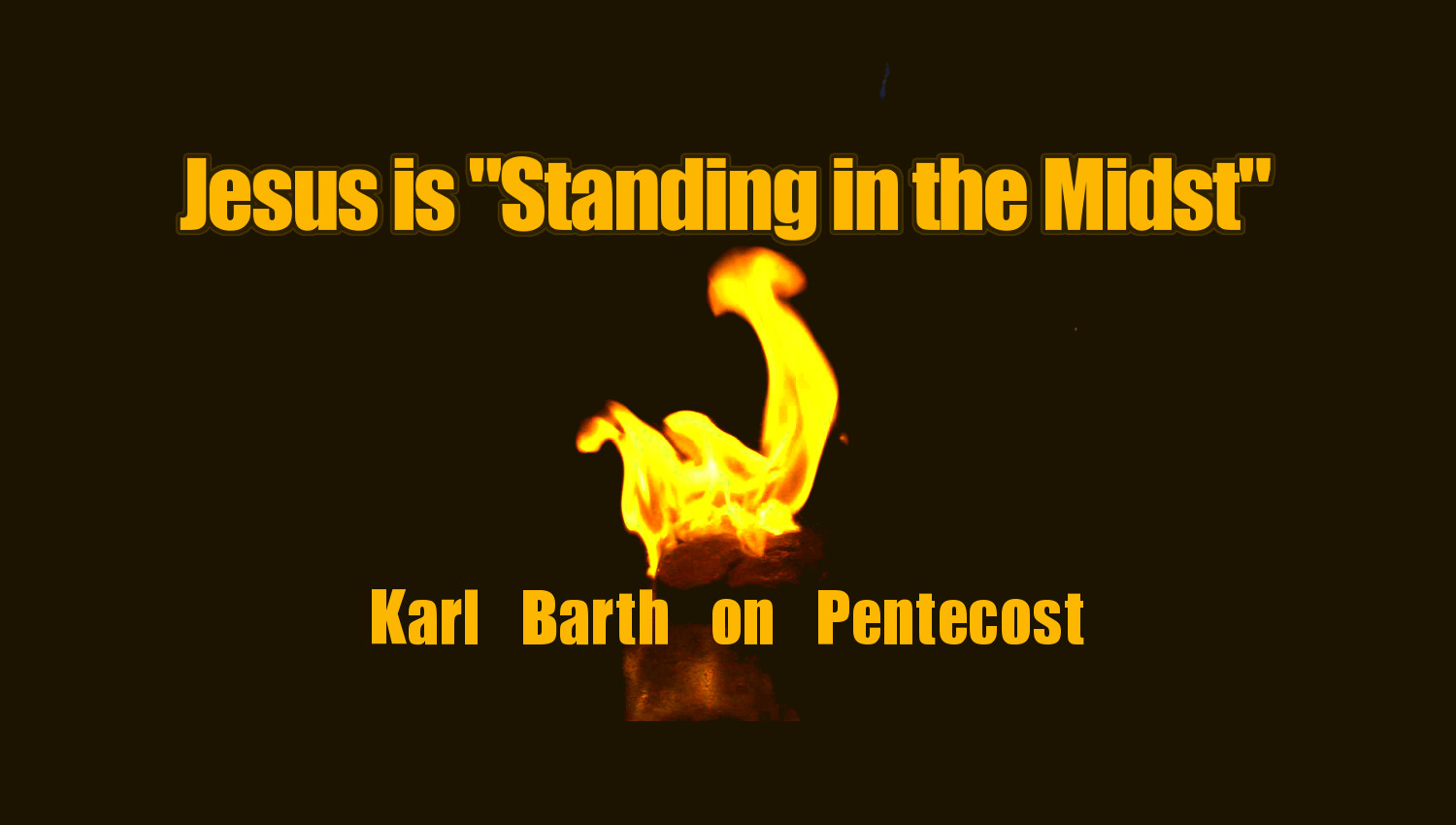 In the early 1920's, Karl Barth preached a sermon on Pentecost to his tiny church in Safenwil, Switzerland. In this sermon, "Come, Creator Spirit!", Barth says that Christians today have much more in common with the strangers and immigrants who came together at Pentecost, than to the Apostles; these immigrants never witnessed Jesus, they spoke foreign languages, and were from distant lands. Today, Christians are far more distant than the immigrants at that arcane event at Pentecost. It's been over 2,000 years since Pentecost first happened, and it has been 500 years since the Reformation; the distance in space and time from today to that mysterious event and its enchanting glossolalia is greater than ever. So how do we make sense of what we read about this beautiful tale of Pentecost born out of literary emotion in Acts 2:4-11?
In the early 1920's, Karl Barth preached a sermon on Pentecost to his tiny church in Safenwil, Switzerland. In this sermon, "Come, Creator Spirit!", Barth says that Christians today have much more in common with the strangers and immigrants who came together at Pentecost, than to the Apostles; these immigrants never witnessed Jesus, they spoke foreign languages, and were from distant lands. Today, Christians are far more distant than the immigrants at that arcane event at Pentecost. It's been over 2,000 years since Pentecost first happened, and it has been 500 years since the Reformation; the distance in space and time from today to that mysterious event and its enchanting glossolalia is greater than ever. So how do we make sense of what we read about this beautiful tale of Pentecost born out of literary emotion in Acts 2:4-11?
Karl Barth interprets Pentecost as more than a beautiful tale. Barth explains Pentecost through Jesus's Lordship over time (a theme that Barth wouldn't fully develop until the Church Dogmatics, Vol III.2, §47 Man in His Time). Barth explains that the resurrection of Jesus, means that Jesus has been raised Lord over time, and stands in eternity over time, and therefore Jesus is equally close to every moment of time and space. Barth quotes scriptures to explain that Jesus "stands in the midst of us" and that Jesus is "the same yesterday, today and the same in all eternity" (Heb 13:8). No matter how distant people become from the event of Pentecost in space and time, Jesus continues to "stand in the midst" of us. Barth concludes with an eucharistic reference, reminding us of our participation in the presence of Jesus whenever we eat the bread and drink the cup till he comes (1 Cor 11:26).
Since, Pentecost 2017 is quickly approaching, I've shared a selection from this sermon, for all to meditate upon during this Easter season.
The Pentecostal Chasm Today
Karl Barth chose a selection of the Pentecost narratives (specifically Acts 2:4,7-11) as the key source to understanding Pentecost today. In this first quotation, Karl Barth grounds us in the text of Acts 2, and re-orientates modern readers into this ancient event of Pentecost:
Acts 2:4,7-9,10-11 "And they were all filled with the Holy Spirit and began to preach with other tongues as the Spirit gave them expression . . . They were all amazed, marveled and began to say among themselves: Behold, are not all these that preach Galileans? How does it come that we each hear in the language wherein we were born? Parthians and Medes and Elamites, and those that dwell in Mesopotamia and Judea and Cappadocia, Pontus and Asia, Phrygia and Pamphylia, Egypt and in the remote Lybia near Cyrene and sojourners of Rome, Jews and proselytes, Cretes and Arabians, we here them speaking in our own tongues the mighty words of God."
Undoubtedly in our reading of the Pentecostal event, we have wondered how all those strangers who had streamed into Jerusalem, the Parthians, the Medes and Elamites and those who dwelt in Mesopotamia and in Judea and Cappadocia, Pontus and Asia, Rome and Egypt, how all these heard the Apostles in their own tongues, so as to understand the great deeds of God about which the Apostles witnessed. We have wondered about it, and perhaps rejoiced over it, as we would a great promise. For we feel remarkably near, or somehow related, to these strangers, as though they were flesh of our flesh and bone of our bone, feeling ourselves even nearer to them than to the Apostles. Just as they came from afar, so do we. We were not present when Jesus lived, taught and wrought, died and rose again. We are separated from Him by centuries, we speak a totally different language we have totally different insights and outlooks. What has a person of today in common with that age, with that generation?
What is told about Jesus is certainly beautiful, but still it is so distant, so distant. Again and again we discover anew that there is terrible chasm which yawns between the now and here, and the then and there. And shall this chasm be bridged, this difference dissolved and be no more? Shall human beings who are separated from Him through time and space hear Him speak as though He were present, out of the mouth of His witnesses? Is there no space nor time separating them from Him and His time? Did He become their contemporary? Is the old distinction between Jew and Greek, Persian, Mede or Elamite, invalid; is there no more such a thing as estrangement or alienation? [2]
The Meaning of Pentecost: Jesus Brings Us Together
Barth's first comments help us understand the distance between us today, and those at the event of Pentecost long ago. In this next quotation, Barth explains how Jesus brings us into proximity with Him, and consequently with each other.
This is what the story of Pentecost tells us. Now if we pleased, we might look upon this story as a beautiful tale born out of literary emotion. But if we have ears to hear we shall hear more than a pretty tale. Here is real knowledge, deep ultimate insights into that existence which Jesus is. What is told us here is that Jesus not only was, but that He is, and will be. He does not exist here or there in a certain place; for Him there is not only a "once" and a "then," but he is yesterday, today and the same in all eternity; in a word, Jesus is "standing in the midst." That is what is told us here. He "stands in the midst" means that what He says is not only a historical utterance of truth which has validity for, and was understood in, a certain time, but here—and wonderful to say—the eternal appeared in the casual, the Godly has appeared in the human. He "stands in the midst," and that means that around Him the world stands still as a circle around its central point. And just as every point on the circle is equidistant from the centrum, just so it is no farther to Him today than it was in times past.
Not without reason is there engraved on our communion table, "Take, eat, this is my body broken for you, my blood which is shed for you for the forgiveness of sins." That is as true today as it was a thousand years ago, and it will be as true a thousand years from now as it is today. He stands as the centrum. This story wishes to tell us nothing else. It tells us that on Pentecost, when He was spoken about, all understood. When speech really tells about Jesus, then there is not a single person who, when asked to understand, could not understand. [3]
Background to Come, Holy Spirit!
Long before Karl Barth wrote the Church Dogmatics, he was the Red Pastor of Safenwil. In this small Swiss countryside town, Barth was a lowly pastor, in a tiny church, preaching to blue-collar workers, advocating for their education and social rights.[1] Barth was working on the second edition to the Epistle to the Romans (1921), that would later make Barth famous worldwide. Years later, Barth's lifetime friend and fellow pastor, Eduard Thurneysen, compiled Barth's Safenwil sermons from 1920 to 1924, and published them in the book Come, Holy Spirit. Thurneysen compiled (and coauthored the written form of) these sermons. This series of sermons were originally preached before Barth's more mature theological works were written, so they may be considered "Early Barth" or during Barth's transition towards the "Later Barth" of the Church Dogmatics.
References:
[^Header Image Background]: CC BY-SA 3.0, Link
[^1]"Karl Barth." Biography | Center for Barth Studies. N.p., n.d. Web. 22 Mar. 2017. <http://barth.ptsem.edu/karl-barth/biography>.
[^2] Barth, Karl. Ed. Karl Julius. ERNST, Elmer George. HOMRIGHAUSEN, and George Warren. RICHARDS. Comp. Eduard Thurneysen. Come Holy Spirit. Sermons. T. & T. Clark: Edinburgh; New York, 1934. 171-73. Print.
[^3] Ibid.



Leave a comment